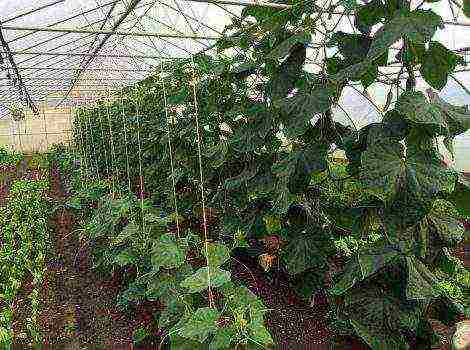Content [show]
WonderWoman
0 0
Grapes on the balcony are a great solution for open structures that need shading. Girlish or wild grapes are used to decorate building facades, fences, hedges and, of course, balconies.

Here is such a facade decor you can create with your own hands.
Classification
The plant belongs to the class of lianas and has a length of up to 15 meters. Depending on the variety, the leaves can have a different shape and color - from yellow to dark purple and crimson.
The two most common grapes are tri-pointed and five-leaf grapes. The first one resembles ivy and is well recognized by its three-lobed, multi-colored leaves.

Tri-pointed wild grapes
The five-leafed one pleases with a green living curtain all summer long and only in autumn it acquires a bright red color. The leaves themselves have an oval five-pointed shape.
Growing grapes
The most comfortable conditions for grapes are northern, western or eastern balconies. Remember, he does not like direct sunlight, he prefers shade or partial shade.
Each plant should have at least 3-4 m of free area. If you have determined the place of growth, you can start landing.
We will need:
- seedling cup (paper, plastic or clay);
- film to protect sprouts from wind and cold;
- complex fertilizer;
- pegs to guide growth;
- rope mesh or chain-link;
- garden tools.
When purchasing seedlings, look at the root system. If the roots of the plant look too small and are wrapped in plastic, skip this purchase. Chances are good that the grape bush will not take root at all. The price of potted plants is slightly higher, but you will receive a guarantee of survival.
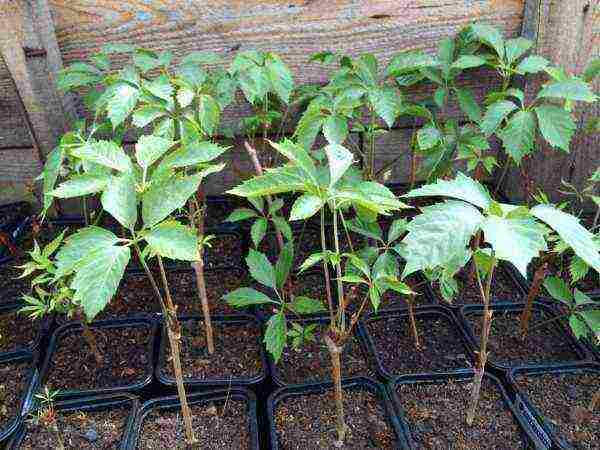
In the photo - seedlings of wild grapes
Maiden grapes prefer humus-rich soils... Initially, it is better to plant the cuttings in small containers, and after they get stronger, "relocate" to larger containers or open ground. The latter option will be relevant for those whose balcony is on the first floor.

Before growing a seedling, carry out the cutting of the cuttings, which promotes the formation of heel roots.
When preparing the soil, take in equal parts mature compost, meadow sandy loam and loamy soil, a purchased universal peat substrate. This will be the optimal soil composition for grapes.
If the planting pot does not have drainage holes, fill the bottom with expanded clay, gravel or crushed fragments of ceramic pots. The size of the drainage backfill should be at least 5-10 cm.
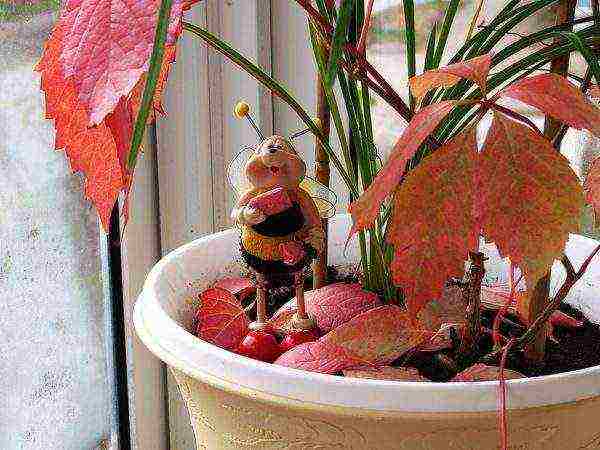
Girlish grapes in boxes and pots must have a thick drainage layer
Dry twigs, crushed leaves, a thin layer of manure or humus can also be placed on the bottom.This layer will be quite loose due to the air cavities necessary for the free germination of the plant roots.
Growing grapes on the balcony is best done in tubs with a volume of at least 100-120 liters. Your choice can be a wooden box or a ceramic pot with a depth of 40 cm.
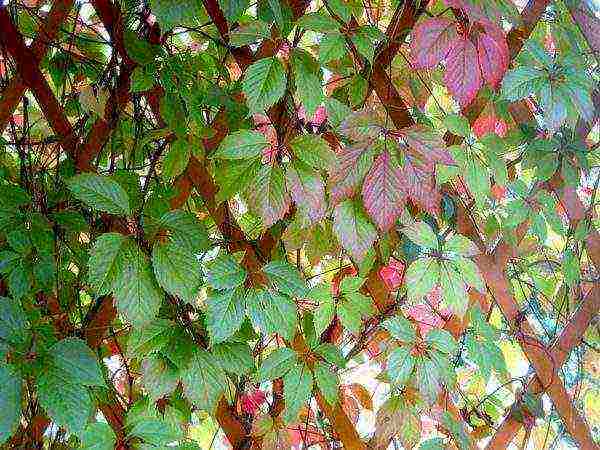
Even growing in a pot requires a solid foundation.
The first two years, the grapes will be trailing single shoots with insignificant thin branches. Position the support immediately to form the crown. As the latter, a lattice made of strips or a wide board with stuffed nails and stretched wire is suitable.
When the shoots reach the edge of the support, pinch them for better branching.
Before the first wintering, young shoots are cut in half, the tub is brought to a warm place, in the spring they are exposed and normal care is resumed. For the next wintering, the plant does not move, but if necessary, the root system is insulated.
Propagation of grapes
Wild grapes on the balcony are propagated by layering, seeds and cuttings.
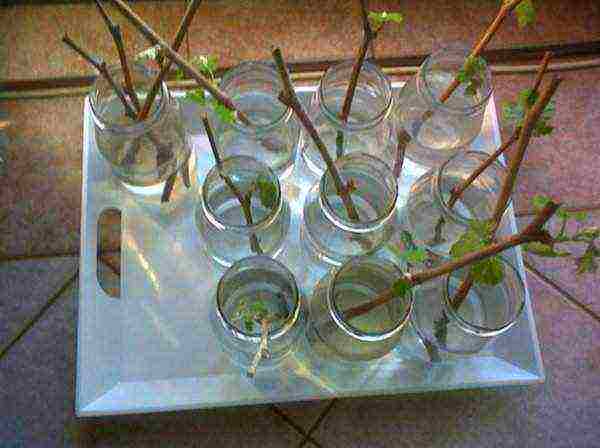
Cutting method of reproduction
| Breeding method | Instructions and recommendations |
| Layers | The simplest breeding method, however, requires a lot of free space, which cannot always be allocated in a typical balcony. The stem (up to 2 m) is buried in waves in the ground, leaving a section on top to the next bud. The distance in this case is reduced to 15 cm. In the spring, rooted cuttings can be separated and transplanted. |
| Seeds | This generative method is the longest, therefore it is used extremely rarely. In late autumn, seeds are obtained from the harvested ripe berries, which are planted to a depth of 1 cm in a prepared nutrient substrate. The first shoots can be expected at the end of next July. |
| Cuttings | The optimal breeding method for urban conditions. When carrying out a planned spring pruning from adult branches, it is necessary to cut blanks of 2-3 buds in size. Cuttings with leaves removed are placed 2/3 in water. With the appearance of the first roots (after 1-1.5 months), the plant can be planted. |
Care rules
Watering and feeding

Planting and grooming can turn girly grapes into bonsai
- Watering is carried out at least once a week. To maintain a sufficient level of moisture, it is better to cover the soil in the pot with a loose layer of needles or tree bark.... Do not be zealous when carrying out this work, otherwise the plant will be deprived of air exchange and mold will appear on the surface.
- Top dressing is applied in the spring using a solution of 50 grams of nitroammofoska. During an active growing season, it is better to supplement the plant with organic fertilizers.
Every year, replace part of the soil in the tub with humus and manure. The procedure is best done in early spring.
- Do not forget to gently loosen the soil, restoring the ability to "breathe" for the roots.
- In order for the grapes to form the necessary shape, the young plant is tied to wooden pegs set in the soil.... As the crown forms, it is necessary to tighten the support-ropes, which will allow the antennae to be fixed and climb up. Also, be sure to periodically prune dry and limp twigs.
Pest control
The grapes are quite resistant to pests and diseases. Most often, you have to deal with such a scourge as aphids. In this situation, I recommend starting by rinsing the leaves with a solution of laundry soap or alcohol.
Summing up

On a landscaped balcony, you can create a cozy place to relax
Girlish grapes on the balcony feel great in a private house and apartment, you just have to find a suitable place and a comfortable tub. Shade-loving plants and flowers can peacefully exist with him in the neighborhood: marigolds, ageratums, viols, nasturtiums, balsams, ever-flowering and tuberous begonias, choose the right company and go ahead for a suitable pot!
It remains for me to offer you a video in this article and regret good luck in balcony gardening. What is already growing on your balcony? Share your secrets with our readers.
September 12, 2016
If you want to express gratitude, add clarification or objection, ask the author something - add a comment or say thank you!
Maiden grapes in your garden
Five-leaf maiden grape is an ideal plant for vertical gardening and decoration. Its branches can be used to strengthen steep slopes. Often people are afraid to use a vine because of the risk of its uncontrolled growth. They are afraid that the grapes can destroy the walls of a brick fence or the foundation of a building. In fact, the branches of the grapes, on the contrary, protect the wall from destruction, from sudden changes in temperature, precipitation and strong winds.
Maiden grapes grow mainly by rooting branches bent to the ground, with little root growth. In order to prevent strong growth of grapes, you can dig limiters into the ground: pieces of slate, metal sheets, boards, or you can initially plant it in a confined space. For example, between the foundation of buildings and a fence or in a container.
Experienced plant collectors cultivate living movable walls from maiden grapes. They put it in 30-liter containers. Near the containers at a distance of 2 meters, poles are also installed 2 meters high. A transverse beam is fixed from above between them. It turns out a frame two by two, a net of nylon threads is pulled onto this frame and the branches of grapes are woven into the cells. A cord is passed along the upper edge of the net so that it can be easily removed from the supports, rolled up or straightened. It turns out a mobile screen. A few years later, when the grapes form a solid green canvas, the entire structure is placed where there is a need for landscaping.
With the help of maiden grapes, you can create an aesthetically beautiful, pleasant-looking landscape, reminiscent of the old garden of a Russian noble estate.
For the winter, containers are buried in the ground. The plant winters well without shelter and is decorative all season. In autumn, the leaves turn scarlet, and bright dark blue inedible fruits hang from the branches.
The maiden grape is a plant for those who want the results to be seen here and now. It grows very quickly, and in height it can rise by tens of meters, if there was a support. Adult plants practically do not require attention to themselves: they are drought-resistant, shade-tolerant and grow on any soil. The only thing that needs to be done is to carry out anti-aging and sanitary pruning once a year. Don't be afraid to prune it too much, the grapes will recover easily and look neat. Cut out old and weak shoots, as well as anything that seems superfluous to you. Take a look around, perhaps, and you have unsightly places that need to be effectively decorated.
How to decorate a toilet, a shed and a compost heap in the country?
The maiden grape is a vine with brightly colored leaves. The leaves can be red, yellow, or green, and the berries are dark blue. The plant is about 8-12 meters long. It is grown mainly on the balcony. Girlish grapes on the balcony are beautiful and original. The plant will decorate not only the balcony, but also the fence and even the wall of the house or summer cottage.
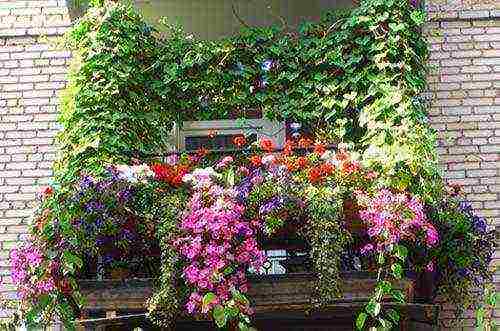
The maiden grape is a vine with brightly colored leaves. The leaves can be red, yellow, or green, and the berries are dark blue.
The maiden grapes bloom in June and July, and the berries appear in early September. The tree bears fruit until October, depending on the climate.
Features of planting grapes
Maiden grapes grow either in the shade or in a semi-dark place.
The soil should be rich in organic matter, humus. The plant should not be planted too close to each other, at a distance of 3 meters.
To grow grapes you will need:
- clay, cardboard or plastic cup for planting a grape sprout;
- a film to cover the pot from cold and wind;
- shovel;
- fertilizers;
- garter ropes;
- poles or stakes for the plant to grow in the right direction;
- garden scissors for pruning the vine in spring;
- watering can.
Back to the table of contents
Growing technology
Back to the table of contents
Purchase 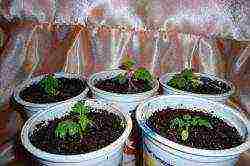
It is better to plant grapes in a semi-sunny place: it will dry out in the scorching sun, and wither in the shade.
When buying seedlings of girlish grapes, you need to pay attention to two points: the graft of the seedling and the roots. If the roots are weak, then they should not be allowed to be wrapped in a plastic bag - the roots should be in a convenient pot.
It is better to plant grapes in a semi-sunny place: it will dry out in the scorching sun, and wither in the shade. If the sun warms the plant, for example, for half a day, then in the fall it will have a luxurious "dress". The soil should be moist and rich in humus. On the balcony, grapes need protection in winter, so you need to plant them in a pot and regularly monitor the moisture of the earth.
Back to the table of contents
Landing 
In the fall, the plant reproduces. The stalk is planted in a pot and covered with a film cap. Before planting in open ground, you need to cut off the leaves from the cutting.
Maiden grapes are planted in spring. It sits in a container, and from the container it can be transplanted both in summer and autumn. Top dressing is necessary. You can use humus or compost for it.
In summer, the soil must be actively moistened. In order for moisture to be better retained in the soil, it can be sprinkled with fine tree bark.
In the fall, the plant reproduces. The stalk is planted in a pot and covered with a film cap. Before planting in open ground, you need to cut off the leaves from the cutting.
Back to the table of contents
Pests
If annoying aphids have appeared on the tips of the plants, then you can get rid of it in two ways. The first method is to rinse the leaves with water. If this option did not help, then treat the leaves and stems with laundry soap; you can also add alcohol to the solution.
Back to the table of contents
Care 
The grape has a peculiarity: it rises up the roof and walls and descends down the same walls and roof.
- Saplings can be planted at any time.
- For this you need a shovel. It is necessary to dig a hole and plant the plant at the same depth at which the seedling in the pot grew.
- Before planting, the seedling in a pot must be watered.
- The seedling is placed at an angle.
- The seedling should be pruned throughout the season. Do not cut in winter. You need to prune branches to normal healthy wood.
- Around the seedling, you need to make a circle for watering.
- Attach a wire nearby so that the plant can hold.
- It is better that it does not twist around the drainpipe: when the foliage begins to fall off, it can clog the pipe.
Back to the table of contents
Maiden grape varieties
Back to the table of contents
Five-leaf maiden grape
The plant has five-part, palmate leaves. The leaves are oval. The plant clings to objects with antennae and rises up. The grape has a peculiarity: it rises up the roof and walls and descends down the same walls and roof. The leaves of such a plant are bright red by autumn and green in spring and summer. The height of the grapes reaches 10 meters.
Back to the table of contents
Tri-pointed maiden grapes 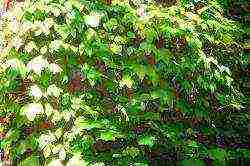
If the plant grows constantly in the shade, then it will not have a bright color in the fall.
The plant has three-lobed leaves and looks like ivy. This is the more popular and common plant variety. The leaves are of different shapes and colors.
Both plants can decorate any kind of fences, gazebos, roofs, balconies and walls. Plants are usually planted for decoration. They grow quickly and are not picky. The main thing is that the soil is suitable and the sun warms up. If the plant grows constantly in the shade, then it will not have a bright color in the fall. If the soil is dry, then the plant needs watering.
Girlish grapes are used as a decoration for flower beds, namely for the background. On the front, you can safely plant roses and other flowers. A flower bed with maiden grapes will look luxurious and very beautiful in the fall.
Back to the table of contents
Varieties of parthenocissus
The maiden five-leaf grape is also called parthenocissus.
His homeland is China. A temperate climate is suitable for it, such as in Russia, Asia, America.But by creating a suitable temperature, the plant can be grown in other climatic zones.
Back to the table of contents
Parthenocissus Henry 
The temperature at which Henry grows well enough is 10-12 degrees.
Description:
- Liana, which has tetrahedral leaves, in the spring the leaves have a bright green color, in the fall they turn into burgundy.
- Practically does not bloom.
- Flowers are small greenish, almost invisible in the axils of the plant. And the berries are small, juicy and bluish in color. They begin to ripen in the fall.
- The temperature at which Henry grows well enough is 10-12 degrees.
- Humidity should be moderate.
- Lighting is essential. The more light, the better the plants will grow.
- Propagated by Henry cuttings.
- Watering is carried out plentiful in summer and spring, moderate in autumn, and does not need watering in winter.
- Pruning, as well as watering, is carried out from spring to autumn, stops in winter.
Back to the table of contents
Parthenocissus attached 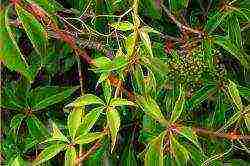
Attached parthenocissus is usually intended for entwining fences, fences.
Attached parthenocissus is a plant from North America, usually intended for entwining fences, fences. Thanks to its antennae, the plant is attached to the support. On the antennae, there are usually no suckers or are observed, but few.
This type of parthenocissus reproduces in three types:
- seeds;
- cuttings;
- layering.
The berries of the plant are blue-black and ripen in July. The leaves are dark green above, light below, and shiny on the sides.
Back to the table of contents
Five-leafed parthenocissus
North American liana plant, attached to the support with tendrils with suction cups. The plant ripens later, in September, the berries are also dark blue, have 4 seeds inside. The plant is resistant to polluted air. Plant height - 15-20 m.
Back to the table of contents
Tri-pointed parthenocissus 
All parthenocissus, but cannot stand shadow and bright sun. There must be a temperate climate, the air temperature is not lower than 10 degrees, watering is required, since they cannot tolerate arid soil.
This plant is a rare species and is already listed in the Red Book. Grows in the Far East. In our conditions, it is difficult for him to survive, in winter it can freeze.
Berries with a bloom of blue-black hue. The plant ripens by September. It has many decorative forms that reproduce only vegetatively. The leaves are large, rough, dark green, shiny in the corners.
All parthenocissus are generally unpretentious, but they cannot stand the shade and bright sun. There must be a temperate climate, the air temperature is not lower than 10 degrees, watering is required, since they cannot tolerate arid soil.
In winter, the plant can freeze, so it needs to be covered and protected from wind and snow. There is no need to water in winter.
In the spring, the plant is pruned and cuttings are used for propagation.
The plant is fed during the period of initial growth, in the old plant the wood is coarse and thick.
Using parthenocissus is a great way to keep yourself busy not only with useful work, but also to please those around you with a beautiful garden or flower bed. You can also enjoy the berries of the plant.
For those who like to have gazebos at home, the parthenocissus will be an ideal shading option in the hot summer and salvation from the scorching sun. In the cozy thickets of parthenocissus, you can create a unique romantic atmosphere.
The parthenocissus has an incredible number of species for every taste and color. Having chosen a certain type of plant to your liking, you need to study all the nuances of its cultivation, since the varieties differ from each other in the conditions of existence.
Showcase Lodzhiya Body
Craftsmen services
Master of finishing works,
5 years of experience, LLC "Stalservice"
Master of finishing works,
Experience 12 years, IE Yavshev
Master of finishing works,
Experience 7 years, LLC "Masterstroy"

